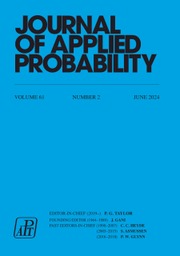Article contents
Simulation-Based Computation of the Workload Correlation Function in a Lévy-Driven Queue
Published online by Cambridge University Press: 14 July 2016
Abstract
In this paper we consider a single-server queue with Lévy input, and, in particular, its workload process (Q t )t≥0, focusing on its correlation structure. With the correlation function defined as r(t):= cov(Q 0, Q t ) / varQ 0(assuming that the workload process is in stationarity at time 0), we first study its transform ∫0 ∞ r(t)e-ϑt dt, both for when the Lévy process has positive jumps and when it has negative jumps. These expressions allow us to prove that r(·) is positive, decreasing, and convex, relying on the machinery of completely monotone functions. For the light-tailed case, we estimate the behavior of r(t) for large t. We then focus on techniques to estimate r(t) by simulation. Naive simulation techniques require roughly (r(t))-2 runs to obtain an estimate of a given precision, but we develop a coupling technique that leads to substantial variance reduction (the required number of runs being roughly (r(t))-1). If this is augmented with importance sampling, it even leads to a logarithmically efficient algorithm.
Keywords
MSC classification
Information
- Type
- Research Article
- Information
- Copyright
- Copyright © Applied Probability Trust 2011
References
- 12
- Cited by

